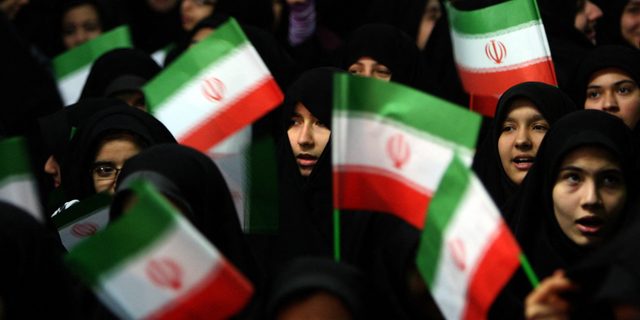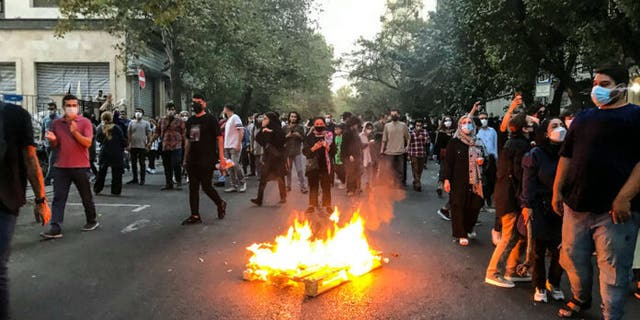close 
Iran Protests: A year in review (WARNING: Contains some graphic content.)
Over 100 days of nationwide protests in Iran have demonstrated the greatest pushback against the decades-old regime and its repressive policies, showing the world that the people demand rights they have long been denied. (CREDIT: The Foreign Desk)
Iranian authorities may be using new technology to help enforce the country’s strict dress code for women, expanding the use of facial recognition technology to issue fines and other penalties for those breaking the rules.
“Many people haven’t been arrested in the streets,” Shaparak Shajarizadeh, who fled from Iran to Canada in 2018 after multiple violations of Iran’s strict laws and became an activist, told Wired in a report Tuesday. “They were arrested at their homes one or two days later.”
Shajarizadeh is one of several observers of Iran who fear that the country’s Islamist regime has begun to weaponize facial recognition technology to find and punish women who flaunt laws about their dress and appearance in public, a setback for activists amid months of protesting for women’s rights and regime change.
The fears that Iran could be using the technology come a year after such a system was proposed by Iranian lawmakers. Their calls were heard by the head of the government agency responsible for enforcing morality laws, who in a September interview said facial recognition would be used “to identify inappropriate and unusual movements,” and a “failure to observe hijab laws.”
IRAN SHUTS DOWN MORALITY POLICE IN RESPONSE TO PROTESTS: REPORT

Schoolgirls wave Iranian flags during a ceremony marking the 33th anniversary of Ayatollah Ruhollah Khomeini’s return from exile at Khomeini’s mausoleum in Tehran.
(Photo By Atta Kenare/AFP Via Getty Images)
Mahsa Alimardani, a University of Oxford researcher who focuses on freedom of expression in Iran, believes there is evidence that the technology is already in use. Speaking to Wired, she cited multiple reports of women who have received citations in the mail for violations of the hijab law despite not having any interactions with law enforcement.
While there could be other explanations for how the women we caught in violation of the law, Alimardani pointed out that the regime has spent years building a biometric database of all citizens, which includes face scans.
For years, Iran has used monitoring of social media and automated digital surveillance to enforce laws and target critics of the regime, distancing itself from the types of physical patrols that eventually sparked months of protests following the death of 22-year-old Mahsa Amini while in police custody.
While Iran reportedly cut back on or abolished the morality police amid the outrage, this was seen by some as a victory for activists. Others noted that Iran could step up its use of technology to fill the void.
IRANIAN CLIMBER REKABI PUT UNDER HOUSE ARREST AFTER COMPETING WITHOUT HIJAB: REPORT
Facial recognition has become a desired tool for authoritarian regimes across the globe in recent years, but not every country has the resources to implement it effectively. That would not be a problem for Iran, which has the technical infrastructure for widespread surveillance.
“Iran is a case where they have both the governmental will and the physical capability,” Cathryn Grothe, a research analyst at Freedom House, told Wired.
Perhaps the most infamous example of widespread use of facial recognition technology is China, which has long used similar technologies to track its citizens and stamp out dissent. The Iranian regime may be benefiting from the Chinese experience to build its own program, purchasing much of its surveillance technology from Chinese camera and artificial intelligence company Tiandy.
Tiandy, one of the largest security camera manufacturers in the world, makes the bulk of its sales in China, but in recent years listed the Islamic Revolutionary Guard Corps and other Iranian police and government agencies as customers on its website.

A fire burns on the streets of Iran as protesters continue to chant.
(Credit: NCRI)
IRAN SENTENCES THREE MORE PROTESTERS TO DEATH FOR ‘WAGING WAR ON GOD’ DESPITE GLOBAL CRITICISM
Last month, the U.S. Department of Commerce sanctioned Tiandy for its role in the oppression of China’s Uyghur Muslims and using technology developed in the U.S. to sell to Iran’s Revolutionary Guard Corps. Intel, at one time, was one of the U.S. companies selling technology to Tianady but said last month that it had ended its relationship with the company.
However, the Iranian regime has already put technology to use, with the country’s traffic enforcement agency installing facial recognition systems in 2020 to issue fines for traffic violations. The technology has also been reportedly used to help enforce the country’s dress code as well, with women receiving text messages warning them about wearing a hijab while in vehicles.
Iranian leaders have also hinted at new types of penalties for those who break the rules, something they believe facial recognition technology can help them enforce while lessening the risks that citizens have negative interactions with police.
Mousa Ghazanfarabadi, who is the head of the country’s parliamentary legal and judicial committee, said last year that he supported penalties that include “exclusion from social services and financial fines” for hijab violations.

Demonstrators in Iran cry out in the streets.
(Credit: NCRI)
CLICK HERE TO GET THE FOX NEWS APP
“The use of face recording cameras can systematically implement this task and reduce the presence of the police, as a result of which there will be no more clashes between the police and citizens,” he said in an interview with Iranian media.
Michael Lee is a writer at Fox News. Follow him on Twitter @UAMichaelLee
